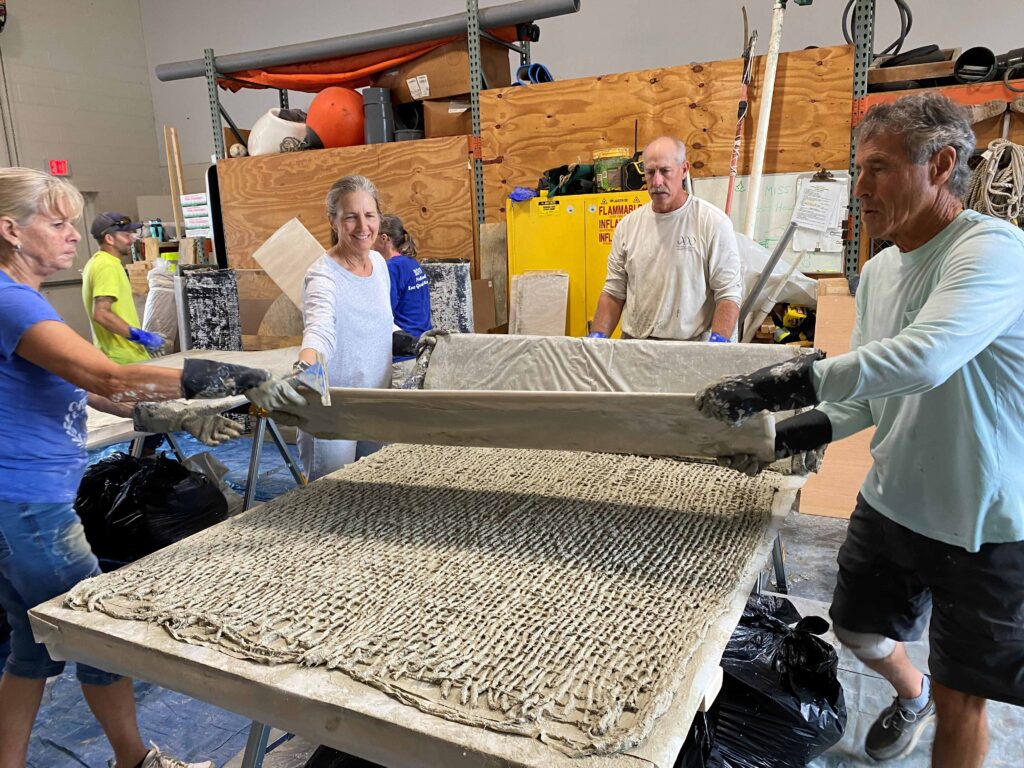By Megan Winslow, UF/IFAS Communications
Living shorelines are gaining popularity in Florida as residents seek sustainable solutions capable of calming waves and restoring habitats.
The materials used to form man-made reefs, however, are not always environmentally friendly or easily accessible. Through a newly published online manual, UF/IFAS and Florida Sea Grant provide step-by-step instructions for a novel approach to the task: do-it-yourself prisms and panels, which can be arranged to create wave breaks.

Crafted from materials available at most home improvement stores, the prisms and panels are an open-source, homemade option volunteer groups around the state are increasingly embracing.
“Although not suitable for every living shoreline project, this is a unique tool to support oyster restoration,” said Savanna Barry, a regional specialized Extension agent with Florida Sea Grant and the UF/IFAS Nature Coast Biological Station in Cedar Key.
Barry is the lead investigator of the Partnership for Plastic-free Restoration of Oyster Shorelines (PROS), a Florida Sea Grant project funded by the Florida Department of Environmental Protection. In 2021, Barry and team set out to identify alternatives to the oyster shell-filled plastic mesh bags commonly stacked to create living shorelines. The bags are inexpensive and easy to assemble, but animals can become entangled in the mesh. The plastic also degrades over time, and it can be released into the environment.
There are businesses that use Portland cement to build plastic-free domes, blocks and panels for living shorelines, but their products are proprietary. Additionally, the pH of Portland cement is thought to hinder the recruitment of beneficial animals.
A PROS development team led by Mark Clark, an associate professor of wetland ecology in the UF/IFAS department of soil, water and ecosystem sciences created a new product from jute netting and calcium sulfoaluminate, a cement material. Referred to as jute-reinforced calcium sulfoaluminate (JR-CSA), it can be molded into various shapes, such as the prisms and panels featured in the manual. It’s strong, fast setting, stronger than Portland cement and doesn’t shrink much. It’s also biodegradable and has a lower carbon footprint than cement options.

“It’s best suited for situations where you need to get a habitat started,” Barry said. “Then, once the oysters and the marsh grasses are established, the initial structure will fade away, and it becomes a self-sustaining natural area.”
The manual is meant to help volunteers work together to build prisms and panels. Over 23 pages, it introduces the concept of nature-based solutions for coastal erosion, provides detailed instructions for creating panels and oyster shell-filled prisms, offers troubleshooting advice and suggests how to arrange the finished objects. A cost breakdown is included: $21.25 for each 2-inch by 48-inch by 48-inch panel and $23.33 for each 12-inch by 48-inch triangular prism. A companion series of online tutorial videos offers supplemental instructions.
PROS team members deployed their first JR-CSA objects in Cedar Key as proof of concept but soon heard from living shoreline enthusiasts across the state requesting workshop training, including representatives from the Choctawhatchee Basin Alliance in Santa Rosa Beach and the Marine Resources Council in Palm Bay. Groups along the Indian River Lagoon have adapted the instructions to create volcano-shaped mounds.
“We’ve seen our volunteers just take off and build these themselves after they’ve watched the process a few times,” Barry said. “You end up having an assembly line of 10 or 15 people, where some volunteers are cutting the jute, some are rolling the prisms. Our best volunteer group built 25 prisms in about two and a half hours.”
The PROS community meets quarterly and welcomes new membership. To learn more, please visit https://sites.google.com/ufl.edu/pros/home.
Banner photo: A reef prism formation at Liza Jackson Park in Fort Walton Beach (Savanna Barry, UF/IFAS). This piece was originally published at https://blogs.ifas.ufl.edu/news/2025/06/23/new-manual-provides-instructions-for-building-environmentally-friendly-man-made-reefs/.
Sign up for The Invading Sea newsletter by visiting here. To support The Invading Sea, click here to make a donation. If you are interested in submitting an opinion piece to The Invading Sea, email Editor Nathan Crabbe at nc*****@*au.edu.



